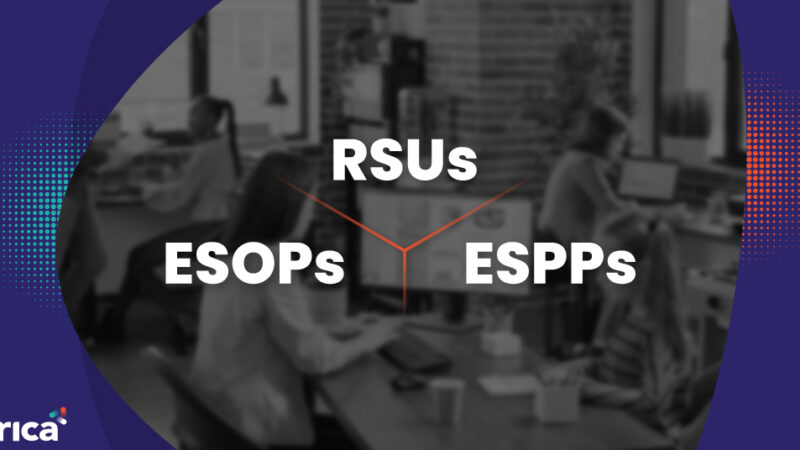
The ESOP Dictionary : All you need to know
- ESOP: The word ESOP is generally used in two contexts:
- First is the literal meaning, which is the Employee Stock Option Plan; this is usually a plan or scheme under which options are given to the employees in a company
- The second meaning is the Employee Stock Options. It’s important to note that options are NOT shares thetrica equitylves. Rather this signifies the ‘option or right’ of the employee to purchase the company’s shares. ESOP is given to the employee via a grant letter with grant date, vesting details, exercise price, etc., clearly mentioned on it.
- ESOP Scheme: A ESOP Scheme holds certain agreed-upon terms and conditions based on which ESOPs are granted and exercised for all the employees in a company
- ESOP Pool: As part of the ESOP adoption in a Startup, a certain number of shares are set aside for ESOP grants to employees. This set of shares is called the ESOP pool and is part of the ESOP scheme document approved by shareholders.
- Grant Date: The date on which ESOPs are issued to the employee
- Grant Letter: The letter given by the company through which ESOPs are issued to the employee
- Vesting: In straightforward and general terms, vesting refers to the amount of time an employee must work before acquiring a certain benefit. Vesting is, therefore, the process by which an employee becomes eligible to exercise their stock options and become a shareholder in the company. Typically the first vesting happens after 12 months and thereafter periodically, maybe every year for 4 years.
- Vesting Period: The period between the grant date and the date on which all the specified vesting conditions of the ESOP grant are satisfied. A very common vesting period is 4 years, with a one-year cliff.
- Accelerated Vesting: This allows an employee to quicken the schedule by which their ESOP vesting happens. Accelerated vesting generally occurs at the time of mergers & acquisitions.
- Vested Options: Number of options for which vesting date has been completed (in the past)
- Unvested Options: Number of options for which vesting date has NOT yet arrived (still in the future)
- Cliff Period: This is the minimum period after the grant date when the first options get vested. In India, it is mandatory to have a minimum of 12 months cliff period.
- Exercise: Literally, this is about the employee exercising the right to purchase shares of the company. Note that employees can exercise (or purchase shares) only after their options have got vested, not before.
- Exercise Period: After vesting, the employee earns the right to buy the shares of the company. However, the employee can buy those shares within a certain period of time. This is called the exercise period.
- Exercise Date: The date on which the employee exercises (his right to purchase shares) and receive shares of the company.
- Exercise Price: The price at which the employee buys the shares. This price is, in most cases, lower than the prevailing share price.
- Exercise Tax: At the time of exercise (purchase of shares), not only does the employee need to pay the exercise price, but they also need to pay an income tax. The notional income is calculated as the difference between the fair market value (FMV) of the shares and the exercise price at the time of exercise. The employee needs to pay income tax on this notional income based on his tax bracket.
- FMV: Fair Market Value of shares is usually obtained by the company to calculate its income tax liability at the time of exercise. Note that the company gets the FMV through a valuation certificate obtained from a merchant banker.
—————-
Let’s take a real example; see the attached Grant Letter, Exercise Letter, and ABC Shares.
Roshan has been granted 1500 ESOPs via this grant letter on Feb 14, 2018 (grant date). The exercise price is INR 500 per option. The options will vest annually over 4 years (vesting period) after a 12 month cliff period. The complete vesting table and dates are as follows:
|
Vesting Date |
Total options vested (till date) |
| Feb 14, 2019 | 375 |
| Feb 14, 2020 | 750 |
| Feb 14, 2021 | 1125 |
| Feb 14, 2022 | 1500 |
After the cliff period, he can exercise his vested options first on Feb 14, 2019, and then on the same date in subsequent years. If he chooses to exercise on the same date (see the attached exercise letter), he will pay:
375 X 500 = INR 1,87,500 as the exercise price
Roshan will also have to pay the exercise tax
Let’s assume that the FMV of the shares is INR 8,500 per share. So, he will pay a tax on his notional income. The notional income can be calculated as
375 X (8500-500) = INR 30 lakh
On this notional income of INR 30 lakh, Roshan has to pay tax as per his tax slab. If the tax rate for his slab is 33%, he needs to pay about INR 10 lakh as income tax in that year.
Now, let’s assume that Roshan decides not to exercise his vested options annually. He leaves the company on Feb 28, 2021, after his third vesting schedule. As of now, he has 1125 vested options. His unvested options (1500-1125 = 375) lapsed the moment he resigned.
But, the company has a policy of allowing employees to exercise within six months of leaving the company. If he doesn’t exercise in this time frame, all of his 1125 vested ESOPs will lapse. If he chooses to exercise, he has to pay a lot of exercise tax (apart from his exercise price); Roshan is thinking hard about what to do 🙂
After a few years, as part of the Series C round, the company provides ESOP liquidity to select employees, including Roshan, for 20% of his vested ESOP. Roshan decides to take part, and he exercises his vested options; he submits the exercise letter to HR and pays the company 1125*500*20% = Rs 1,12,500. He also has to pay the income tax amount to the company. The company will allot 1125*20% = 225 Equity shares to Roshan, and he will receive the duly signed share certificates. Then these shares will be transferred to the investor, and Roshan will, in turn, receives the sale amount.
—————-
ESOP & CAP Table
Management simplified
Get started for free





